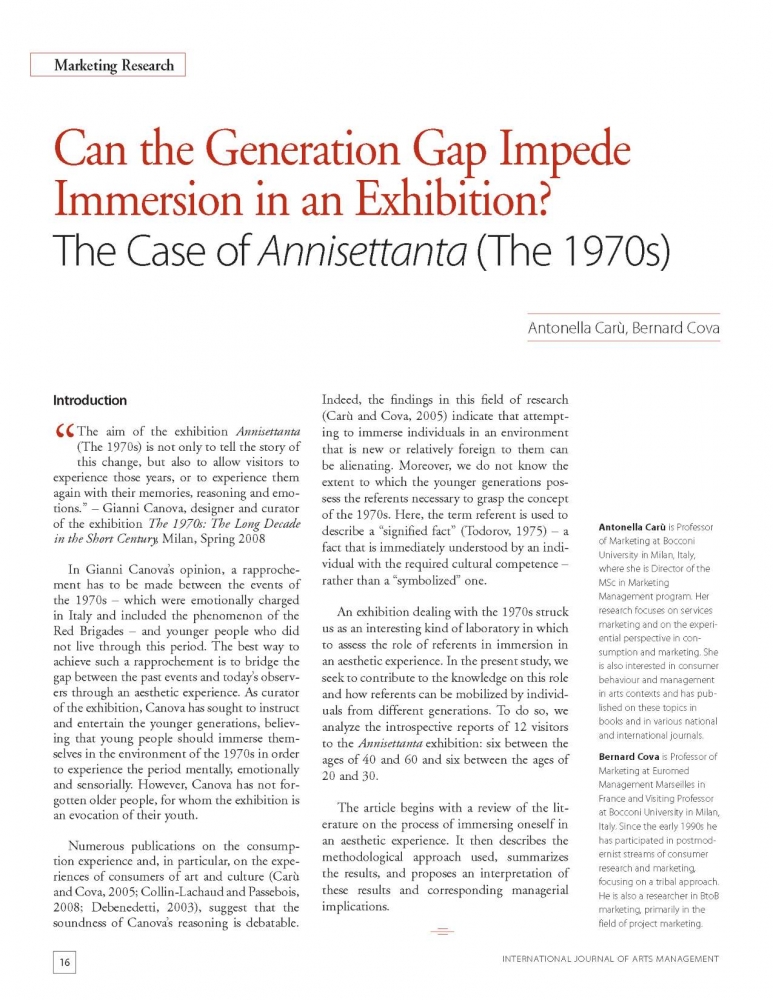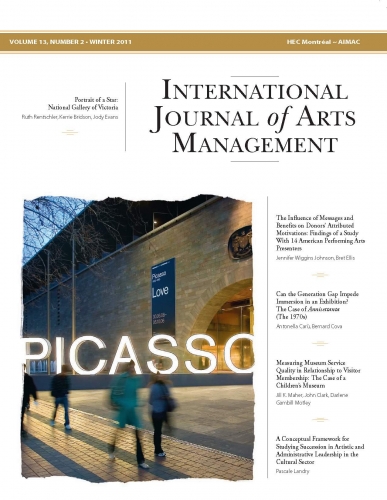Can the Generation Gap Impede Immersion in an Exhibition? The Case of Annisettanta (The 1970s)
Produit: Article
21,00 $ CA
Antonella Carù, Bernard Cova
Antonella Carù is Professor of Marketing at Bocconi University in Milan, Italy, where she is Director of the MSc in Marketing Management program. Her research focuses on services marketing and on the experiential perspective in consumption and marketing. She is also interested in consumer behaviour and management in arts contexts and has published on these topics in books and in various national and international journals.
Bernard Cova is Professor of Marketing at Euromed Management Marseilles in France and Visiting Professor at Bocconi University in Milan, Italy. Since the early 1990s he has participated in postmodernist streams of consumer research and marketing, focusing on a tribal approach. He is also a researcher in BtoB marketing, primarily in the field of project marketing.
ABSTRACT
One way to reduce the distance between consumers and aesthetic objects is to use referents that provide consumers with a sense of security and that facilitate their immersion. The authors use an exhibition in Milan, Italy, titled The 1970s: The Long Decade in The Short Century as a laboratory to investigate whether young people are able to immerse themselves in an experiential context that is made up of referents (in this case, to the 1970s decade) that are mostly alien to them. The results show that, together with a lack of meaningful referents, the inability to make links between these referents constitutes a major barrier to immersion. The authors highlight the need for curators to manage referents in the framework of an exhibition and establish the complementary role that a guide might play, especially for people belonging to different generations.
KEYWORDS
Exhibition, experience, generation, guide, immersion, referent
RÉSUMÉ
Un moyen de réduire la distance entre les consommateurs et les objets esthétiques consiste à utiliser des référents qui leur fournissent un sentiment de sécurité et facilitent leur immersion. Les auteurs ont choisi une exposition à Milan (Italie) intitulée The 1970s: The Long Decade in The Short Century comme laboratoire pour découvrir si les jeunes sont capables de s’immerger dans un contexte expérientiel dont les référents (dans ce cas, à la décennie 1970) leur sont, pour la plupart, totalement étrangers. Les résultats indiquent que, combinée à une absence de référents significatifs, l’incapacité d’établir des liens entre divers référents constitue un obstacle majeur à l’immersion. Les auteurs soulignent la nécessité pour les conservateurs de gérer les référents dans le cadre d’une exposition et de reconnaître le rôle complémentaire que peut jouer un guide, surtout pour ceux qui perçoivent une distance entre eux et la manifestation artistique.
MOTS CLÉS
Exposition, expérience, génération, guide, immersion, référent
RESUMEN
Una manera de reducir la distancia entre el objeto estético y el consumidor es recurrir a referentes que le procuran a este último un sentimiento de seguridad facilitándole así la inmersión. Utilizando como laboratorio la exposición Los Años Setenta: una larga década de un breve siglo, presentada en Milano, Italia, los autores investigan hasta qué punto la juventud puede sumergirse en un contexto vivencial compuesto de referentes que le son en su gran parte ajenos, en este caso los de los años setenta. La investigación muestra que la ausencia de referentes significativos capaces de establecer el vínculo con la vivencia de los jóvenes, constituye una barrera importante que dificulta la inmersión. Los autores destacan la necesidad, para los comisarios en el marco de una exposición, de manejar los referentes de manera a que éstos desempeñen el papel complementario que un guía desempañaría, sobre todo para personas de generaciones distintas.
PALABRAS CLAVE
Exposición, experiencia, generación, guía, inmersión, referente

